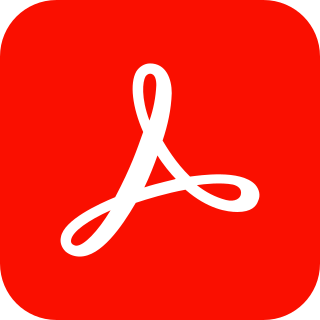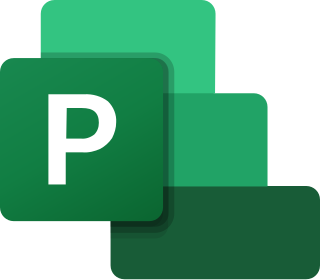A file viewer is a software application that represents the data stored in a computer file in a human-readable form. The file contents are formatted in a meaningful way, then displayed on the screen, printed out, or read aloud using speech synthesis.
In human–computer interaction and user interface design, cut, copy, and paste are related commands that offer an interprocess communication technique for transferring data through a computer's user interface. The cut command removes the selected data from its original position, while the copy command creates a duplicate; in both cases the selected data is kept in temporary storage. The data from the clipboard is later inserted wherever a paste command is issued. The data remains available to any application supporting the feature, thus allowing easy data transfer between applications.

Adobe Acrobat is a family of application software and Web services developed by Adobe Inc. to view, create, manipulate, print and manage Portable Document Format (PDF) files.

A comma-separated values (CSV) file is a text file that uses a delimiter to separate values. The delimiter is often a comma, giving rise to the name of this file format.
A clipboard manager is a computer program that adds functionality to an operating system's clipboard. Many clipboards provide only one buffer for the "copy and paste" function, and it is overwritten by each new "copy" operation. The main task of a clipboard manager is to store data copied to the clipboard in a way that permits extended use of the data.
Transcoding is the direct digital-to-digital conversion of one encoding to another, such as for video data files, audio files, or character encoding. This is usually done in cases where a target device does not support the format or has limited storage capacity that mandates a reduced file size, or to convert incompatible or obsolete data to a better-supported or modern format.

Microsoft Project is a project management software product, developed and sold by Microsoft. It is designed to assist a project manager in developing a schedule, assigning resources to tasks, tracking progress, managing the budget, and analyzing workloads.
Computer-assisted audit tool (CAATs) or computer-assisted audit tools and techniques (CAATTs) is a growing field within the IT audit profession. CAATs is the practice of using computers to automate the IT audit processes. CAATs normally include using basic office productivity software such as spreadsheets, word processors and text editing programs and more advanced software packages involving use statistical analysis and business intelligence tools. But also more dedicated specialized software are available.
Multiplicity is a computer program that enables one keyboard and mouse to access two or more client computers from a host computer. It was developed for Stardock as part of their ThinkDesk subscription service, but is available separately.
A number of vector graphics editors exist for various platforms. Potential users of these editors will make a comparison of vector graphics editors based on factors such as the availability for the user's platform, the software license, the feature set, the merits of the user interface (UI) and the focus of the program. Some programs are more suitable for artistic work while others are better for technical drawings. Another important factor is the application's support of various vector and bitmap image formats for import and export.
Data conversion is the conversion of computer data from one format to another. Throughout a computer environment, data is encoded in a variety of ways. For example, computer hardware is built on the basis of certain standards, which requires that data contains, for example, parity bit checks. Similarly, the operating system is predicated on certain standards for data and file handling. Furthermore, each computer program handles data in a different manner. Whenever any one of these variables is changed, data must be converted in some way before it can be used by a different computer, operating system or program. Even different versions of these elements usually involve different data structures. For example, the changing of bits from one format to another, usually for the purpose of application interoperability or of the capability of using new features, is merely a data conversion. Data conversions may be as simple as the conversion of a text file from one character encoding system to another; or more complex, such as the conversion of office file formats, or the conversion of image formats and audio file formats.
Selections, cut buffers, and drag-and-drop are the mechanisms used in the X Window System to allow a user to transfer data from one window to another. Selections and cut buffer are typically used when a user selects text or some other data in a window and pastes in another one. Drag-and-drop is used when a user selects something in a window, then clicks on the selection and drags it into another window.
The clipboard is a buffer that some operating systems provide for short-term storage and transfer within and between application programs. The clipboard is usually temporary and unnamed, and its contents reside in the computer's RAM.

Live Clipboard is an extensible data format and set of UI technologies used to support copy/paste operations between web applications in browsers, and between web and desktop applications. Unlike the typical copy/paste experience in browsers, the Live Clipboard mechanism never needs to display a security dialog to the end user, thus delivering a more streamlined user experience.
The following tables compare notable reference management software. The comparison includes older applications that may no longer be supported, as well as actively-maintained software.

Pivot Animator is a freeware application that allows users to create stick-figure and sprite animations, and save them in the animated GIF format for use on web pages and the AVI format.
Data portability is a concept to protect users from having their data stored in "silos" or "walled gardens" that are incompatible with one another, i.e. closed platforms, thus subjecting them to vendor lock-in and making the creation of data backups or moving accounts between services difficult.
Geospatial PDF is a set of geospatial extensions to the Portable Document Format (PDF) 1.7 specification to include information that relates a region in the document page to a region in physical space — called georeferencing. A geospatial PDF can contain geometry such as points, lines, and polygons. These, for example, could represent building locations, road networks and city boundaries, respectively. The georeferencing metadata for geospatial PDF is most commonly encoded in one of two ways: the OGC best practice; and as Adobe's proposed geospatial extensions to ISO 32000. The specifications also allow geometry to have attributes, such as a name or identifying type.

KeePass Password Safe is a free and open-source password manager primarily for Windows. It officially supports macOS and Linux operating systems through the use of Mono. Additionally, there are several unofficial ports for Windows Phone, Android, iOS, and BlackBerry devices, which normally work with the same copied or shared (remote) password database. KeePass stores usernames, passwords, and other fields, including free-form notes and file attachments, in an encrypted file. This file can be protected by any combination of a master password, a key file, and the current Windows account details. By default, the KeePass database is stored on a local file system.

Google Sheets is a spreadsheet application included as part of the free, web-based Google Docs Editors suite offered by Google. Google Sheets is available as a web application; a mobile app for: Android, iOS, Microsoft Windows, BlackBerry OS; and as a desktop application on Google's ChromeOS. The app is compatible with Microsoft Excel file formats. The app allows users to create and edit files online while collaborating with other users in real-time. Edits are tracked by which user made them, along with a revision history. Where an editor is making changes is highlighted with an editor-specific color and cursor. A permissions system regulates what users can do. Updates have introduced features that use machine learning, including "Explore", which offers answers based on natural language questions in the spreadsheet. Sheets is one of the services provided by Google that also includes Google Docs, Google Slides, Google Drawings, Google Forms, Google Sites and Google Keep.







